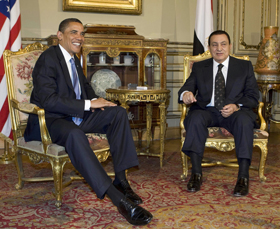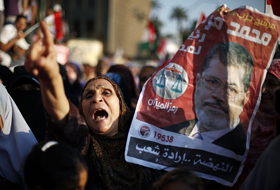Between pragmatism and idealism
In
Login if you are already registered
(no votes) |
(0 votes) |
PhD in Politics, Head of the Centre for Analysis of Middle East Conflicts, the RAS Institute for US and Canadian Studies
Over the last six decades, the Washington analysts have invariably regarded the US relations with Egypt as a key element of its Middle East policy. Egypt’s role in the US Middle East strategies was due, primarily, to its unique geo-political position (at the junction between Asia and Africa and access to the Eastern Mediterranean, its full control over the Suez Canal and the common borders with Israel) as well as its leadership in the Arab world in terms military power and political influence.
Over the last six decades, the Washington analysts have invariably regarded the US relations with Egypt as a key element of its Middle East policy. Egypt’s role in the US Middle East strategies was due, primarily, to its unique geo-political position (at the junction between Asia and Africa and access to the Eastern Mediterranean, its full control over the Suez Canal and the common borders with Israel) as well as its leadership in the Arab world in terms military power and political influence. The importance of the country of the Pyramids for the US Middle East policy is borne out by the scale of the financial injections – Washington provided aide worth $71.6 billion between 1948 and 2011. Since 1979 Egypt has remained the second-largest recipient of US financial assistance after Israel [1]. Meanwhile, there have been significant changes in the country’s political elite brought about by the upheavals of the 2011-2012 Arab Spring in Egypt. The army top brass that has dominated for 60 years (since the 1952 Young Officers’ Revolution) is starting to cede the reins of power to not just ‘civil’ parties but, primarily, to the Moslem Brotherhood who the generals have fought since 1954 after the Islamists’ first attempt on the life of Gamal Abdel Nasser.
Over the last months, the USA has vigorously adapted to Egypt’s new political realities, for the events of the Papyrus Revolution have been unfolding rather fast.
The milestone political changes:
The first – resignation of Hosni Mubarak (February 2011) and coming to power of the Higher Military Council (HMC);
The second – the Islamists’ victory in the parliamentary elections in March 2012;
The third – victory of the Islamist Muhammed Mursi in the presidential elections in June 2012;
The fourth – removal of the HMC generals by President Mursi, the replacement of top brass and stripping it of the powers of the country’s political life main regulator.
The Obama administration had, at each stage, to adjust its policy towards Egypt in such a way as to retain the country as its major partner in the Arab world. But the US foreign policy expert community continues to discuss the topic:”Has the USA lost Egypt as a result of the Obama policy or, conversely, retained it as a strategic partner?”
Is America to bear all the blame?
It seems that a search for an answer to the question will be rather long, as the situation in the country of the Pyramids is far from stable and that underpins an uncertainty that has emerged in the relations between Cairo and Washington. The relations between the United States and Egypt are suffering the ‘challenges of a transition period’; at that, the USA is forced to sustain substantial political losses. Virtually all political forces in Egypt level criticism at Washington – the opposition groups (both religious and secular) - for the attempts to back Mubarak at the early stage of the revolution (let alone the three decades of such backing), and later – for supporting the HMC, since the opposition views the generals as the ‘carryover from the Mubarak regime’, the secular opposition – for allegedly ‘supporting the Islamists’ and the HMC generals – for aid to non-profit organisations… Overall, it has become ‘trendy and advantageous’ in Egypt to distance oneself from the USA.
The mass protests in Cairo and Alexandria in January 2011 caught the Obama administration off-guard. The swiftly unfolding developments forced Washington to make a fundamental strategic choice – either to back the unpopular-in-the country, but ‘own’ dictator, or to sacrifice him for the sake of retaining the US influence in Egypt. The Washington analysts often failed to properly assess the events witnessed in Cairo in the second part of January 2011. The statements and specific actions by the Obama administration conspicuously demonstrated its positive reaction to what was taking place as it could not assess, in full measure, the scale and scope of the developments or their ramifications. Thus, the US Secretary of State Hillary Clinton spoke highly of President Hosni Mubarak in the first days of the civil unrest stating that his government was ‘quite stable” and he ‘was trying to find possible answers to the legitimate demands of the people of Egypt’. Moreover, Frank Wisner, the US administration’s special envoy to Egypt, called on Mr. Mubarak, at some point, to stay in power, saying: “President Mubarak’s continued leadership is critical” [2]. The White House, however, tried to backtrack on the envoy’s statement thus demonstrating a lack of coordinated approach short of disarray.
Costs of democratisation
Modern Egypt has been and, to a certain extent still is, a ‘country of conflict’ for the US foreign policy. With a vested interest to retain the country of the Pyramids in its sphere of influence, Washington was forced to collaborate with the authoritarian army regime relinquishing the ‘democratic principles’ formally underpinning the US foreign policy. The cold war served, for many years, as a pretext for Washington to disregard to what extent its various allies were democratic.
But unlike, for example, Saudi Arabia and its neighbour Arab monarchies, there has always been an opposition to the military regime in Egypt, and not only religious – the Muslim Brotherhood (it has functioned in the country since 1928), but secular opposition as well – the oldest nationalist liberal Wafd party, the leftist organisations and parties linked with the name of Gamal Abdel Nasser (the Nasserites) and the European-type modern liberal parties, apart from the civil movements and organisations. It is noteworthy, that the military regime’s successive leaders tried to secure backing by the opposition forces often playing them off against one another. Thus, the first President Nagib relied not only on the army, but also on the Wafd nationalists and the Islamists, while the next President Anwar Sadat tried to play the Islamists’ card against the Nasserites. Hosni Mubarak, who became president after Sadat’s assassination by the Islamists, resorted to harsh repressive measures against the Muslim Brotherhood and, distancing himself from the Nasserites, placed stakes on the army and the bureaucratic apparatus.
The Washington strategists, making their primarily pragmatic calculations, could not but factor in a fairly mature potential of the political opposition that had taken shape a long time ago in Egypt. This was also underpinned by an important US foreign policy tenet to ‘facilitate promotion of democracy in the world’. Moreover, after the end of the cold war and the disintegration of the USSR, Washington had increasingly fewer arguments in favour of its stake in Egypt solely in President Mubarak. But Washington was not going to relinquish its reliable partner either, as the US policy in the 1990s, conceptually boiled down to the idea of ‘facilitating the expansion of Mubarak’s support through liberalisation of his regime with reliance on the secular parties’.
Already in the mid-1990s, Washington started to establish contacts with the various parties of the Egyptian opposition (including the Islamists). This US approach elicited, at times, obvious displeasure from Mubarak’s associates who insisted that all US-financed projects to ‘promote democracy’ in Egypt be painstakingly coordinated with Egypt’s leadership. This concerned mainly the USAID projects, as Mubarak objected, for example, against part of the US financial aid going to the non-governmental organisations, and all the more so – to the independent activist groups.
Up till 2004, the George Bush, Jr. administration had tried to agree with Mubarak on the conditions of providing US aid to Egyptian not-for-profit organisations, but to no avail. Then, the US Congress adopted a resolution providing that such assistance would be granted without prior coordination with the government of the recipient country [3]. Already in 2005 the USAID started to provide grants directly to Egypt’s not-for-profit organisations (NPOs) drawing a negative reaction from the country’s authorities.
The ‘NPO factor’ became one of the crucial irritants in the relations between the USA and Egypt in 2005 and 2006 and the Secretary of State Condoleezza Rice tried to minimise it. Michael Rubin, the distinguished scholar from the conservative American Enterprise Institute describes the fluctuations of the US policies in those years in the following way:
“While President Bush sought to break this dynamic (placing the stake on the dictator), the State Department quickly reverted to business as usual. While Secretary of State Condoleezza Rice called for democracy in Egypt in 2005, less than two years later, she pointedly avoided the term during her return visit to Cairo. In 2006, Francis Ricciardone, the U.S. ambassador in Cairo, told Egyptian students that Egyptian ruler Hosni Mubarak was so popular, he could even win an election in America” [4].
The USA and a ‘democratic takeover’ by Muhammed Mursi
From the very beginning of his presidency, Barak Obama has demonstrated a heightened interest in Egypt, even compared with Israel, the US strategic ally. While on a visit to Cairo in June 2009, he made a speech at the capital’s University, underscoring, among other, the US readiness to facilitate the development of democracy in Egypt [5]. But in order to distance himself from his predecessor, Obama clearly stressed that his administration declined to impose democracy from outside in favour of backing democratic processes maturing from inside. Mubarak who, contrary to the protocol, did not attend Obama’s speech at the Cairo University was critical of the statement. Not surprisingly, the civil activists in Egypt interpreted the statement as a signal of US endorsement. The slogans of the liberally-minded activists reminded Obama, during the Papyrus revolution, of his commitment to back the ‘matured-from-inside democracy’ in Egypt.
In February 2011, in the peak developments at Tahrir Square, Barak Obama put aside his uncertainties and took a clear-cut stance in support of the demonstrators. His statement of 10 February 2011 - the day of Hosni Mubarak’s resignation - reads: “The Egyptian government must put forward a credible, concrete and unequivocal path toward genuine democracy…To that end, we believe that the emergency law should be lifted...” [and] “…the Egyptian civil society should address the key issues confronting Egypt’s future:…revising the Constitution and other laws to demonstrate irreversible change; and jointly [with the opposition] developing a clear roadmap to elections that are free and fair” [6].
Elected in line with the Road map, President of Egypt Muhammed Mursi made an unexpected move on 12 August – he dismissed the most influential HMC brass including Marshal Mohammed Tantawi and the chief of staff Sami Hafez Enan who Washington considered ‘trustworthy partners’. He instead appointed ‘younger generals’ thus eliminating a two-centre governance with the elected civil Islamist president getting full supreme powers.
Mursi’s actions drew serious criticism from the secular political circles of Egypt as well as the religious minorities, especially the Christians, who viewed the HMC leadership as defenders against the ‘Islamists’ absolute power’. Mursi seemed to have disturbed the existing balance of powers that could have secured a gradual transition to a new political system. But it is noteworthy that no criticism came from the Obama administration after Mursi’s maneuvre. This allowed a conjecture that the step by Egypt’s president had been, to a certain extent, coordinated with Washington, or, at the very least, had been made in the spirit of the recommendations by the Obama administration.
Suffice it to remind, that on a visit to Cairo the US Secretary of State Hillary Clinton made a statement on 15 July, on the eve of her meeting with the HMC leader marshal Mohammed Tantawi, that their discussions would focus on ‘facilitating efforts to return the military to the role of ensuring national security.’ Having paid tribute to the HMC leadership for holding free elections in the country, the US Secretary of State described the prevailing situation in the following way: “It is evident that the people of Egypt are in the middle of challenging negotiations on transition (to a new political system - A. Sh.) covering creation of Parliament, approval of a new Constitution and re-establishment of all presidential powers”. That is, Washington de facto insisted on the re-establishment of the powers of the elected Islamist President Mohammed Mursi and on the ‘army going back to the barracks” [7].
However, the Egyptian secular parties took this US stance as a ‘concession to the Islamists’ and as readiness to sacrifice the democratic process for the sake of a ‘deal with the Muslim Brotherhood’. The leadership of the secular parties challenge Mursi’s election victory (according to the official returns, his opponent Ahmed Shafik got over 40% of the votes) maintaining that it had been ‘rigged’ by the Central Electoral Commission and the generals ‘with US assistance’ with a view to avoid the threat of a ‘civil war’ in Egypt. At that, the Islamists, once they had gained power, already began to ‘demonstrate their anti-democratic nature’. That was the reason the secular parties staged protest rallies against Hillary Clinton’s visit to Cairo. The spokespersons for the Obama administration maintain, in their turn, that the basis of their approach to Egypt is the development of democratic institutions and procedures with due account taken of the will of the Egyptian people.
Towards a new partnership model
Clearly, the United States is trying to transition to a new model of partnership. Washington expects to pragmatically interact with both the Islamist president’s team as well as the army top brass whose role henceforth will mainly be limited by ensuring security. In future, should the election procedures remain, political forces, namely the European-type secular parties, more welcome by Washington – may come to power in Egypt.
As far as the Islamist President Mohammed Mursi is concerned, Washington maintains that not only the USA but its allies in the region – the conservative Arab monarchies of the Gulf - will retain some leverage on him. Therefore, the Americans assume that the probability of Egypt reaching out beyond the existing regional political and strategic alliances is fairly low in the foreseeable future. So, the strategists in the Obama administration believe that Egypt’s new government and elite will fit into the existing regional alliances adapting their ideological attitudes to these goals.
1. Sharp J. Egypt: Transition under Military Rule // Congressional Research Service, June 21, 2012 - www.crs.gov RL33003
2. Kristof N. Obama and Egypt’s Future// The York Times, February 9, 2011, NYT
3. Sharp J. Egypt: Transition under Military Rule, June 21, 2012 // Congressional Research Service, 7-5700, www.crs.gov, RL33003, p.17.
4. Rubin M. US policy in the wake of the Arab Spring //American Enterprise Institute, Nov.4, 2011
5. Remarks by The President / On A New Beginning – Cairo University, June 4, 2009 // The White House
6. President Obama on Egypt, 10 Feb. 2011 // The White House
7. Clinton meets Egypt generals after urging 'smooth transition' // AFP, Sunday 15 Jul 2012.
(no votes) |
(0 votes) |








